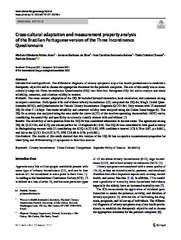Mostrar el registro sencillo del ítem
Cross-cultural adaptation and measurement property analysis of the Brazilian Portuguese version of the Three Incontinence Questionnaire
| dc.contributor.author | Alem, Michele Elisabete Rubio | |
| dc.contributor.author | Silva, Jordana Barbosa da | |
| dc.contributor.author | Beleza, Ana Carolina Sartorato | |
| dc.contributor.author | Chaves, Thais Cristina | |
| dc.contributor.author | Driusso, Patricia | |
| dc.date.accessioned | 2023-01-17T17:38:14Z | |
| dc.date.available | 2023-01-17T17:38:14Z | |
| dc.date.issued | 2022-01-05 | |
| dc.identifier | https://doi.org/10.1007/s00192-021-05036-x | por |
| dc.identifier.citation | ALEM, Michele Elisabete Rubio; SILVA, Jordana Barbosa da; BELEZA, Ana Carolina Sartorato; CHAVES, Thais Cristina; DRIUSSO, Patricia. Cross-cultural adaptation and measurement property analysis of the Brazilian Portuguese version of the Three Incontinence Questionnaire. International Urogynecology Journal, v. 33, p. 3053–3060, 2022. Disponível em: https://repositorio.ufscar.br/handle/ufscar/17224. | * |
| dc.identifier.issn | 1433-3023 | por |
| dc.identifier.uri | https://repositorio.ufscar.br/handle/ufscar/17224 | |
| dc.description.abstract | Introduction and hypothesis The differential diagnosis of urinary symptoms may allow health professionals to establish a therapeutic objective and to choose the appropriate treatment for the patient's complaint. The aim of this study was to cross-culturally adapt the Three Incontinence Questionnaire (3IQ) into Brazilian Portuguese (3IQ-Br) and to analyze test-retest reliability, construct, and criterion validity in women. Methods The cross-cultural adaptation of the 3IQ-Br included forward-translation, back-translation, and consensus among an expert committee. Participants with and without urinary incontinence (UI) completed the 3IQ-Br, King's Health Questionnaire (KHQ), and Questionnaire for Female Urinary Incontinence Diagnosis (QUID-Br). Only women with UI answered 3IQ-Br after 7–10 days. Test-retest reliability and construct validity were analyzed using the Cohen linear kappa (k). The 3IQ-Br accuracy was analyzed using the area under the curve (AUC) of the receiver-operating characteristic (ROC) curve, considering the sensitivity and specificity to correctly classify women with and without UI. Results The reliability of each question from the 3IQ-Br was considered substantial in the test-retest. The agreement among 3IQ-Br, QUID-Br, and KHQ was almost perfect for UI diagnosis (k > 0.8). The 3IQ-Br was considered to have good accuracy in distinguishing women with UI considering the KHQ (AUC 0.83, 95% confidence interval [CI] 0.78 to 0.87, p < 0.001), and fair to the QUID-Br (AUC 0.73, 95% CI 0.68 to 0.78; p < 0.001). Conclusions The results of this study showed that this version of the 3IQ-Br has acceptable measurement properties for identifying and differentiating UI symptoms in Brazilian women. | eng |
| dc.description.sponsorship | Fundação de Amparo à Pesquisa do Estado de São Paulo (FAPESP) | por |
| dc.format.extent | 3053–3060 | por |
| dc.language.iso | eng | eng |
| dc.publisher | Universidade Federal de São Carlos | por |
| dc.relation.ispartof | International Urogynecology Journal | eng |
| dc.rights | Attribution-NonCommercial-NoDerivs 3.0 Brazil | * |
| dc.rights.uri | http://creativecommons.org/licenses/by-nc-nd/3.0/br/ | * |
| dc.subject | Urinary incontinence | eng |
| dc.subject | Cross-cultural comparison | eng |
| dc.subject | Reproducibility of results | eng |
| dc.subject | Reliability | eng |
| dc.title | Cross-cultural adaptation and measurement property analysis of the Brazilian Portuguese version of the Three Incontinence Questionnaire | eng |
| dc.type | Artigo | por |
| dc.publisher.initials | UFSCar | por |
| dc.publisher.program | Programa de Pós-Graduação em Fisioterapia - PPGFt | por |
| dc.subject.cnpq | CIENCIAS DA SAUDE::MEDICINA::SAUDE MATERNO-INFANTIL | por |
| dc.description.sponsorshipId | 2018/26718-9 | por |
| dc.publisher.address | Câmpus São Carlos | por |
| dc.contributor.authorlattes | http://lattes.cnpq.br/8898319491890063 | por |
| dc.identifier.url | https://link.springer.com/article/10.1007/s00192-021-05036-x | por |
| dc.publisher.department | Departamento de Fisioterapia - DFisio | por |
| dc.citation.volume | 33 | por |

